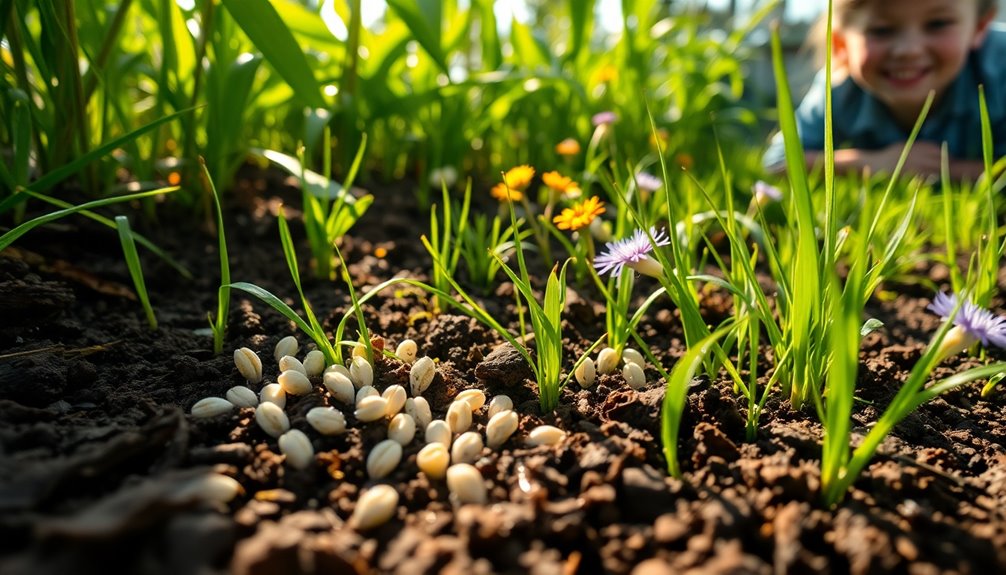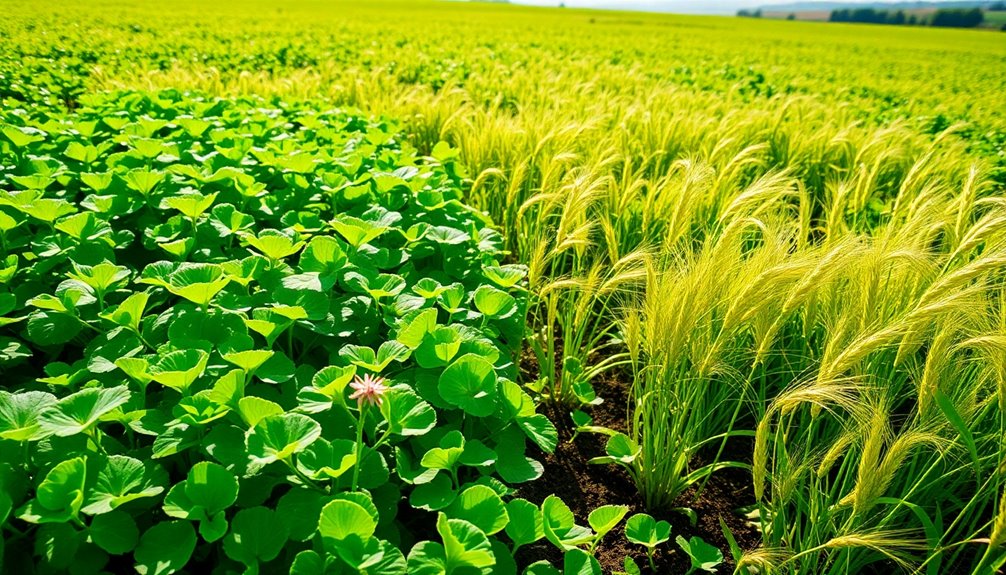Forage oats can amaze you by germinating in just 3 to 4 days when conditions are ideal. Typically, you'll see sprouts within 7 to 14 days. Soil temperature plays a big role; it should stay between 50°F and 86°F for the best results. Consistent moisture is essential too. If the soil's too dry or too cold, germination can get delayed. Make sure to plant the seeds 1 to 2 inches deep to help them establish well. If you want to know more tips for successful oat growth, there's plenty more interesting information to explore!
Key Takeaways
- Forage oats typically germinate in 3 to 14 days, with ideal conditions yielding sprouting in as little as 3 to 4 days.
- Average germination occurs around 7 days when soil moisture and temperature are optimal.
- Soil temperature should be maintained between 50°F and 86°F to enhance germination speed.
- Consistent moisture is crucial; inadequate water can delay germination by up to 2 weeks.
- Planting depth of 1 to 2 inches is essential for maintaining seed-to-soil contact and moisture retention.
Germination Timeframe
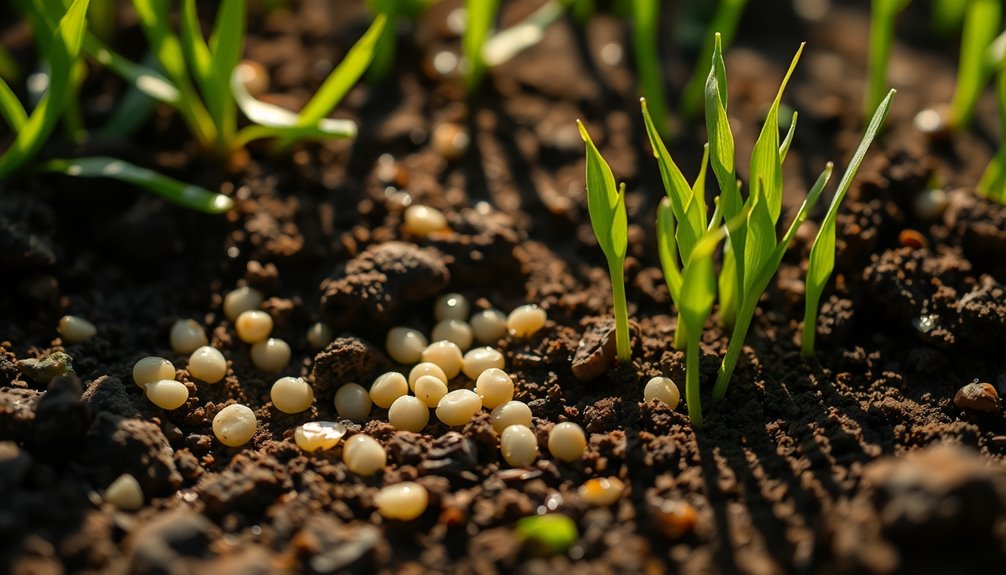
When you're planting forage oats, understanding the germination timeframe is vital. Typically, these seeds germinate in just 3 to 14 days, but under ideal conditions, you could see sprouting in as little as 3 to 4 days. On average, if everything's right—like soil moisture and temperature—you can expect your oats to sprout within around 7 days.
To maximize the potential for seed germination, aim for an ideal soil temperature between 50°F and 86°F. This range greatly affects how quickly your seeds will start to grow. Consistent moisture is also important; without it, your oats might take longer to germinate.
Make sure to plant your seeds at a depth of 1 to 2 inches, as this helps facilitate growth.
However, keep an eye on environmental factors. Poor conditions, such as excessive runoff, can delay germination by up to 2 weeks. By carefully managing these variables, you can improve your chances of a successful and timely oat crop.
Key Environmental Factors
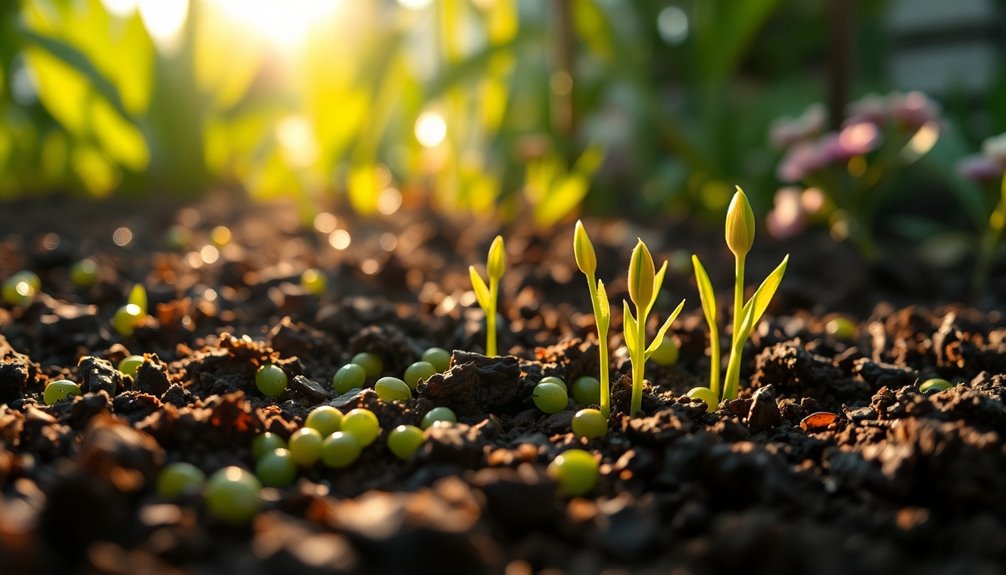
Understanding the key environmental factors that influence oat germination can greatly enhance your planting success.
First, pay attention to soil temperature, as it plays a significant role in how quickly your oats will sprout. Ideally, the soil temperature should range between 50°F and 86°F. When temperatures are within this range, you can expect germination in just 3 to 4 days.
Next, guarantee consistent moisture throughout the germination process. Without adequate moisture, your oats might experience delays of up to 2 weeks. It's essential to keep the soil moist but not soggy; too much water can hinder seed to soil contact, which is important for successful germination.
Finally, be mindful of soil pH, as it should be between 6.0 and 7.0 for maximum nutrient availability. Poor pH levels can affect nutrient uptake, further delaying germination.
Additionally, excessive runoff can disturb seed to soil contact, leading to poor establishment of your crop. By managing these key factors, you'll set the stage for healthy and timely oat germination.
Planting Experiences
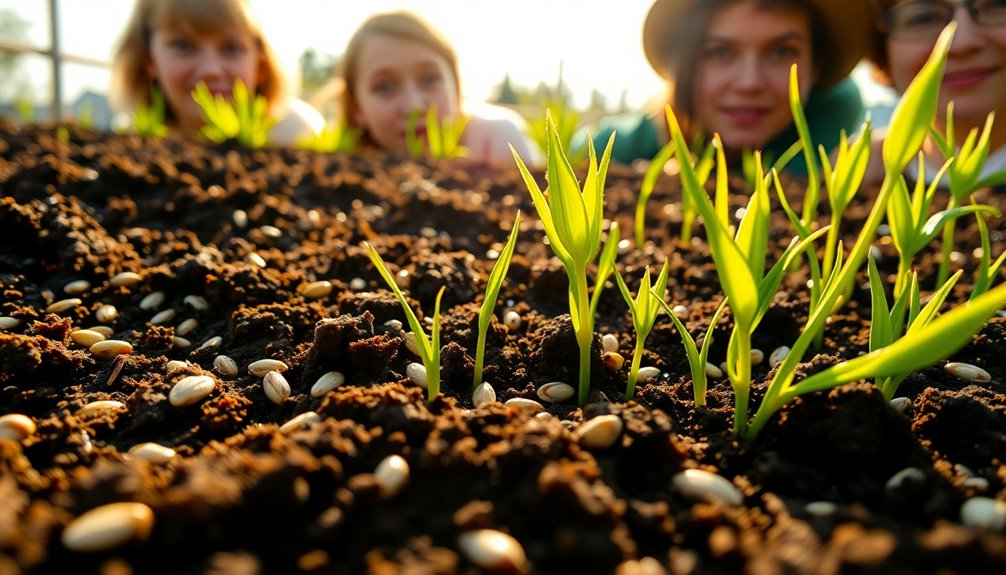
Many gardeners share their planting experiences with oats, often highlighting the thrill of watching tiny green shoots break through the soil. You might find that forage oats can germinate within 7 to 14 days under ideal conditions, with some even sprouting as quickly as 3 to 4 days after planting.
If you pay attention to your planting dates and guarantee adequate soil moisture, you'll likely witness impressive growth.
Many gardeners have noted that in regions with sufficient rainfall, those vibrant green patches of oats appeared around 7 days post-rainfall. This quick germination shows the importance of moisture in the process.
If conditions aren't right—like soil temperatures outside the 50°F to 86°F range—you could face delays, pushing germination to up to 2 weeks.
Keep an eye out for wildlife, too! Deer and hogs can disrupt your food plot, munching on your newly sprouted oats. Staying vigilant shortly after planting will help you protect your crop and enjoy the full satisfaction of a successful germination experience.
Best Planting Practices
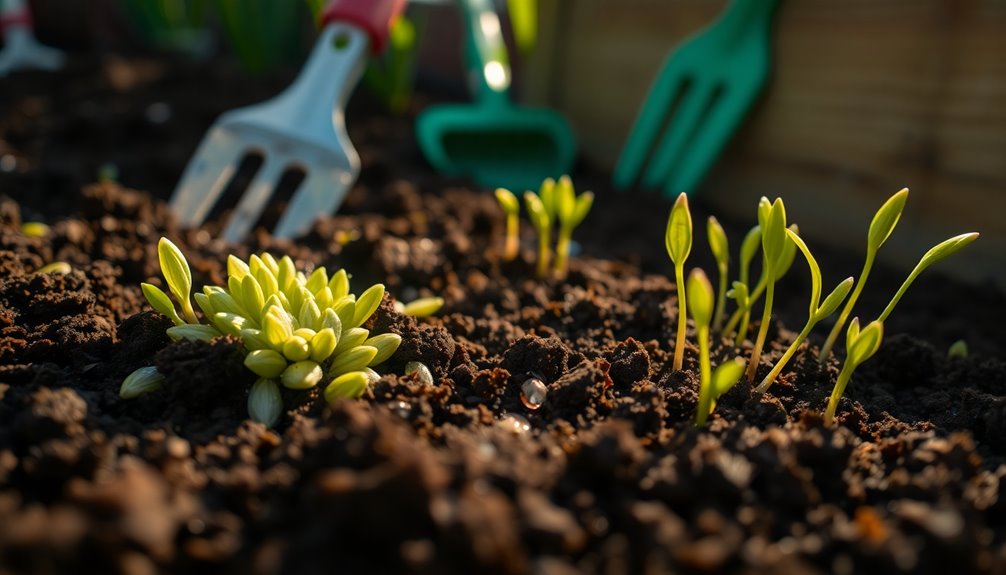
Watching your oats sprout is just the beginning; implementing best planting practices can greatly enhance your success. To guarantee peak germination, plant your forage oats at a depth of 1 to 2 inches. This depth helps maintain seed-to-soil contact and moisture retention, essential for sprouting.
Here are some tips to keep in mind:
- Maintain consistent moisture during the germination phase, as this is critical for seed absorption, allowing your oats to sprout in about 3 to 14 days.
- Keep soil temperature between 50°F and 86°F. Warmer temperatures can speed up germination, often making it happen within just 3-4 days.
- Conduct soil testing to achieve a pH level between 6.0 and 7.0, promoting better growth and enhancing overall germination success.
Proper seedbed preparation is also key; loosen the soil and incorporate organic matter to improve fertility and drainage before sowing your oats.
Nutritional and Ecological Benefits
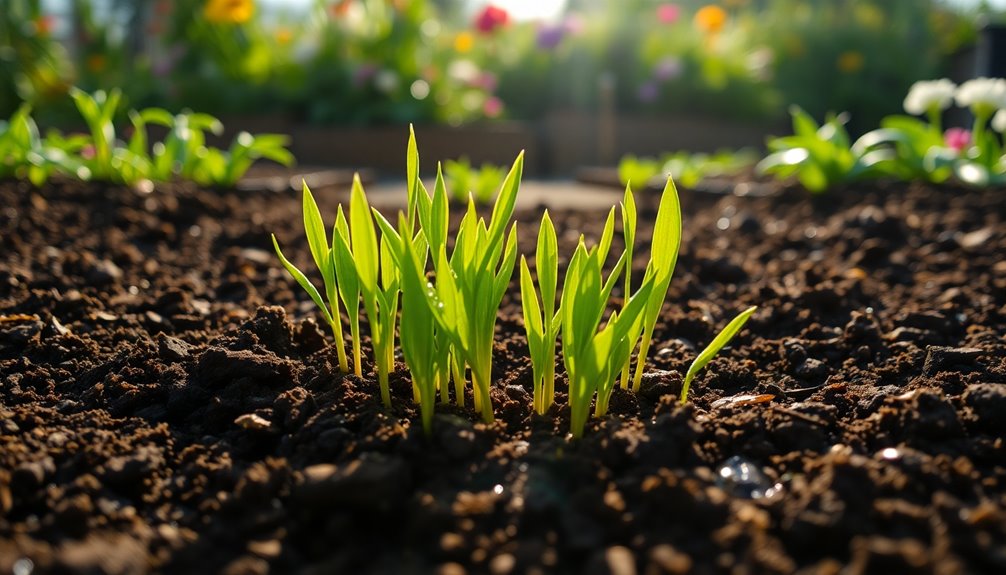
Forage oats offer a wealth of nutritional and ecological benefits that make them a valuable asset in agricultural systems. Their high nutritional value, particularly in protein and fiber, provides excellent forage for wildlife, especially deer during hunting season. This makes them an ideal choice for those looking to enhance wildlife habitats.
Beyond their role in feeding animals, oats greatly improve soil health. As a cover crop, they prevent soil erosion and protect against nutrient runoff, promoting biodiversity by supporting various soil organisms.
Their deep rooting system aids in water retention and nutrient cycling, optimizing soil health while reducing the need for chemical fertilizers.
Additionally, oats can produce substantial biomass, which, when left on the ground post-harvest, acts as mulch. This mulch not only suppresses weeds but also retains moisture, creating a more sustainable growing environment.
By incorporating forage oats into your agricultural practices, you're not just enhancing the nutritional landscape for wildlife, but you're also contributing to a healthier ecosystem and more resilient soil.
Embracing these benefits translates to a more sustainable and productive agricultural system for you and future generations.
Frequently Asked Questions
How Long Does It Take for Forage Oats to Germinate?
When you're planting forage oats, you can expect them to germinate in about 3 to 14 days. Under ideal conditions, like the right soil temperature and moisture, they might sprout in just 3 to 4 days.
Typically, you'll see average sprouting around the 7-day mark. To guarantee success, plant the seeds 1 to 2 inches deep and keep the soil consistently moist.
Poor conditions can delay germination, so keep an eye on the weather!
How Long Does It Take for Oat Seeds to Germinate?
When you plant oat seeds, you can expect them to germinate in about 3 to 14 days, depending on the conditions.
If the soil temperature stays between 50°F and 86°F, you might see sprouting in as little as 3 to 4 days. Under average conditions, it usually takes around 7 days.
Just remember, consistent moisture and planting at a depth of 1 to 2 inches are key to speeding up the process.
How Fast Will Oats Germinate on Top of Ground?
Imagine your garden as a stage, where seeds dance beneath the sun's spotlight.
When you plant oats on top of the ground, they typically germinate in 3 to 14 days. With the right conditions—adequate moisture and warm soil—those little dancers might take just 3 to 5 days to make their debut.
But if your stage is dry or too cool, they might take their time, delaying their performance up to two weeks.
How Late Can You Plant Buck Forage Oats?
You can plant buck forage oats as late as mid-October, depending on your local climate and frost dates.
However, if you plant too late, you might face reduced germination rates due to cooler soil temperatures.
Ideally, aim for late summer to early fall to allow for proper establishment before winter.
While late planting can still offer benefits like quick ground cover, keep an eye out for potential frost damage.
Conclusion
In just a week or two, you'll see your forage oats sprouting, transforming your garden into a lush green sea reminiscent of a medieval banquet feast. By understanding the factors that influence germination and adopting best practices, you'll optimize this process. The benefits, both nutritional and ecological, are well worth the wait. So, roll up your sleeves, get planting, and watch your garden thrive like a knight's castle in full bloom!

